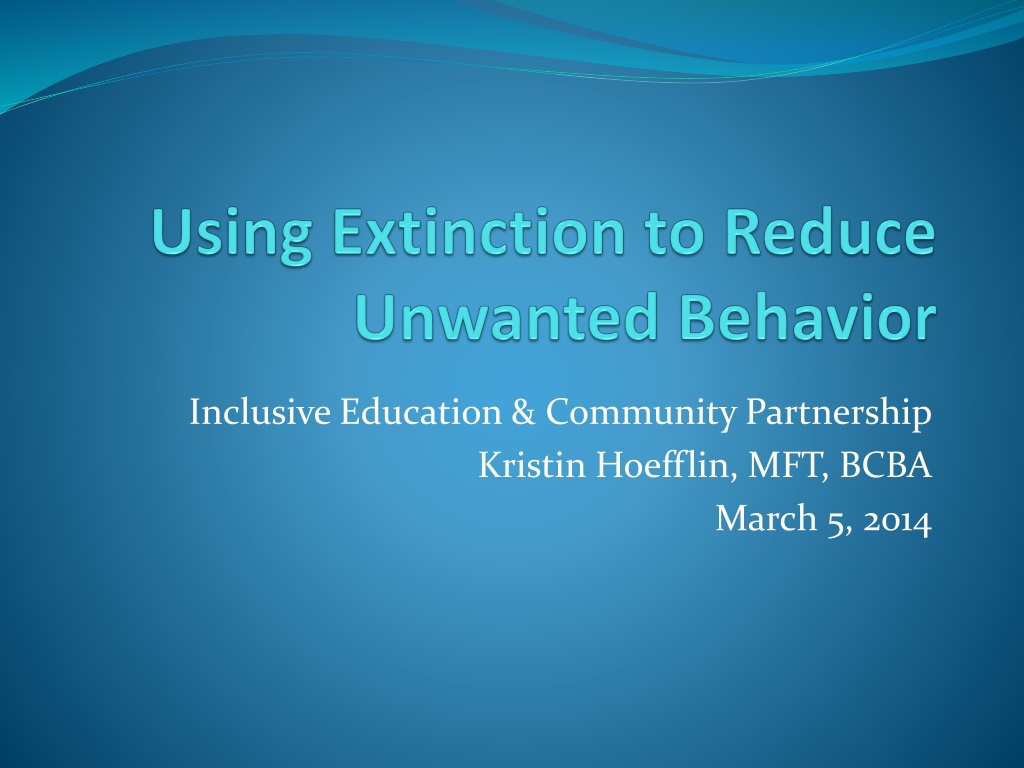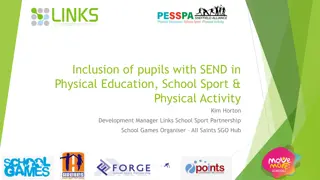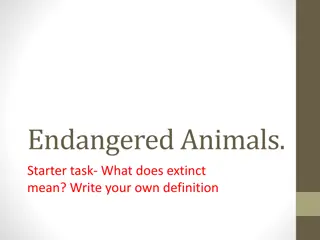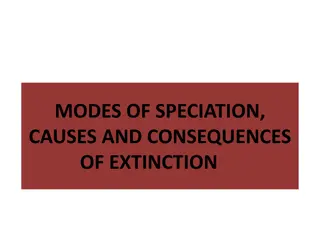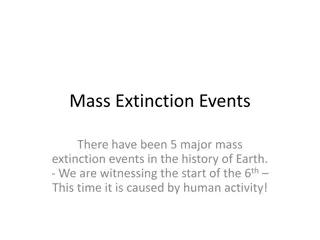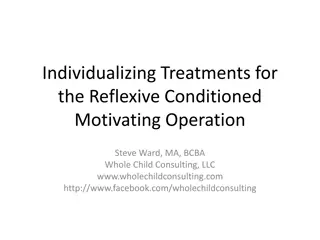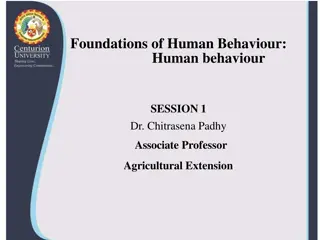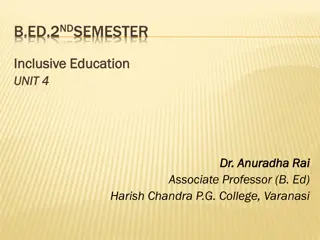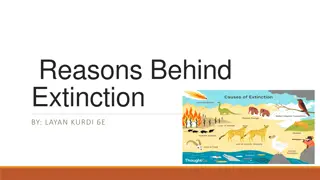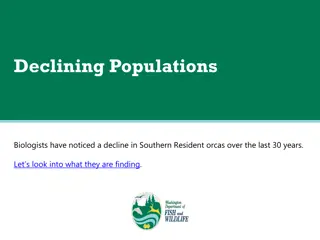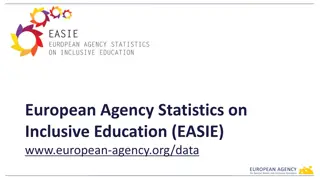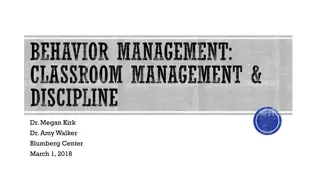Understanding Behavior Establishment and Extinction in Inclusive Education
Behavior establishment and extinction are crucial concepts in the field of inclusive education. Behaviors are reinforced based on antecedents and consequences, with extinction occurring when reinforcement is discontinued. Different types of extinction target behaviors maintained by positive or negative reinforcement, or sensory input. Extinction involves strategies like planned ignoring, denying access, or preventing escape responses, all aimed at decreasing undesired behaviors effectively and ethically.
Download Presentation

Please find below an Image/Link to download the presentation.
The content on the website is provided AS IS for your information and personal use only. It may not be sold, licensed, or shared on other websites without obtaining consent from the author. Download presentation by click this link. If you encounter any issues during the download, it is possible that the publisher has removed the file from their server.
E N D
Presentation Transcript
Inclusive Education & Community Partnership Kristin Hoefflin, MFT, BCBA March 5, 2014
How are Behaviors Established? Behaviors serve a purpose (or function) When behaviors are reinforced, they increase Antecedent Behavior Consequence Child is given a worksheet Child screams and rips up worksheet Child is given a break and work is delayed for 10 minutes Peer has a desired toy Child hits peer Peer drops toy and cries to teacher Teacher is giving instructions to class Child shouts out loudly several times Peers laugh and teacher verbally reprimands Child
What is Extinction? Extinction occurs when reinforcement of a previously reinforced behavior is discontinued As a result, the frequency of that behavior decreases in the future Note that the extinction procedure does not prevent occurrences of the behavior, rather the environment is changed so that the problem behavior no longer produces reinforcement *Cooper, Heron, & Heward (2007)
Types of Extinction Extinction of behavior maintained by positive reinforcement Attention Tangible Extinction of behavior maintained by negative reinforcement (removal/avoidance of an aversive stimulus) Escape Extinction of behavior maintained by automatic reinforcement Sensory
Extinction Involves Based on the function of the behavior, extinction involves: The withholding of attention by ignoring the behavior (i.e. Planned Ignoring) Denying access to tangible items or activities Not allowing the learner to escape or avoid a task or situation Preventing reinforcing sensory feedback
Planned Ignoring Involves no verbal contact, no physical contact, no eye contact, and no emotional reaction during or following attention-maintained behavior Consistency is crucial! May involve reinforcing peers for ignoring and tolerating the behavior
Modifying Planned Ignoring Sometimes complete Planned Ignoring is not possible When behaviors escalate to the point of being dangerous to self or others (e.g. physical aggression, SIB, extreme property destruction, elopement, etc.) When behaviors cannot be completely ignored: Provide high levels of attention when student is engaged in desired behavior When target behavior occurs, redirect the behavior with minimal attention (e.g. no verbal interaction, no emotional reaction, minimize eye contact, least restrictive physical redirection, etc.)
Denying Access to Tangibles Start with environmental management Preferred items may be hidden or not available Adults maintain control of reinforcers Withhold access to tangible items/activities until student utilizes appropriate functional communication If student gains access to item, consider pros and cons of physically removing that item from the student Consider less physical methods to restrict access (e.g. unplug computer, place recess toys in locked cabinet, etc.)
Escape Extinction Involves not allowing the person to escape or avoid the non- preferred task through: Physical guidance to complete Keeping the person in the instructional area until he/she completes the task Repeated presentation of the instruction until the person follows through with the task
Escape ExtinctionChallenges We cannot force a student to complete a task The student may be strong-willed enough to wait it out until the end of the school day Discuss with team about at-home consequences Repeated instruction may inadvertently reinforce the behavior with attention (the behavior may be maintained by both escape and attention)
Modifying Escape Extinction Alternative to blocking escape Keep all forms of potential reinforcement under adult control Escape from demands is permitted, but all forms of reinforcement after escape are fully restricted until the student returns and complies Examples: Turning off TV every time child gets out of his/her chair Removing reinforcing toys if child attempts to leave social interaction area *Schramm, Institute Knospe-ABA
Modifying Escape Extinction Alternative to physical prompting and repeated instruction Put every behavior other than the behavior of interest on extinction in doing so, we wait for the child to engage in the task without the use of physical prompts Only repeat the instruction, make eye contact, or engage with the child who has refused a task when he/she has demonstrated a motivation for reinforcement and are more likely to perform the behavior of interest *Schramm, Institute Knospe-ABA
Extinction of All Behavior Other Than the Behavior of Interest
Sensory Extinction Behaviors maintained by automatic reinforcement (sensory) are placed on extinction by masking or removing the sensory consequence Examples: Pillow under head for head-banging Mittens on hands for nose-picking Padding a desk to reduce noise from pencil-tapping Wearing goggles for eye-poking Note that response blocking is not an extinction procedure, however may be very effective in conjunction with extinction
Effects of Extinction Initial increase in the frequency, duration, and/or intensity of the behavior is called an Extinction Burst An extinction burst typically starts during the first 1-3 sessions and lasts for a few sessions After the Extinction Burst, you will see a gradual decrease in the behavior Spontaneous Recovery occurs when the behavior reappears after it has diminished to near-zero or zero levels
Planning for the Burst Inform treatment team that the behavior will get worse before it gets better Planning for extinction-produced aggression will reduce the likelihood that the aggression is inadvertently reinforced An extinction burst means that the reinforcer that was previously maintaining the behavior has been successfully identified, and therefore the intervention has a good chance of being effective! Continue to consistently withhold the reinforcer through the extinction burst
Resistance to Extinction Continued responding during an extinction procedure is considered resistance to extinction Variables that may effect response to extinction include: Continuous vs. Intermittent Reinforcement Strength of the establishing operation (EO) or motivation of the behavior Number, magnitude, and quality of the reinforcement Number of previous extinction trials Response effort
Dont Use Extinction Only! Extinction procedures should always be used in conjunction with other, positive reinforcement procedures such as: Antecedent strategies to set the environment for success Functional Communication Training (FCT) Differential Reinforcement of Alternative Behavior (DRA) Differential Reinforcement of Other Behavior (DRO) Non-Contingent Reinforcement
When NOT to Use Extinction Extinction should not be used for behaviors that are likely to be imitated by others Extinction is not typically used for extreme behaviors that may cause harm to self or others Extinction should not be used as a primary or sole intervention for extreme behaviors In this case, response-blocking may be necessary The student s aggressive behavior can be ignored while the victim is protected and tended to Can be combined with positive reinforcement for desired behaviors
Functionof Behavior Extinction Procedure Example Other Procedures Useful with Extinction To gain attention Planned Ignoring Learner is calling out to get the teacher s attention, and the teacher does not respond to the calls Functional Communication Training (FCT) Differential Reinforcement Non-Contingent Reinforcement To escape/avoid demands or interaction Deny opportunity for breaks or to escape the task Learner screams whenever he is asked to complete a new task to avoid the demand. The teacher continues with the task even though the learner is screaming Functional Communication Training (FCT) Differential Reinforcement Non-Contingent Reinforcement
Functionof Behavior Extinction Procedure Example Other Procedures Useful with Extinction To gain sensory stimulation or to avoid unwanted stimulation Change the consequence (from the sensory behavior) so it is no longer reinforcing Learner bangs his head on a desk so the teacher puts a soft pillow to block the reinforcing stimulation Response Interruption/ Redirection Functional Communication Training (FCT) Differential Reinforcement Non-Contingent Reinforcement To gain tangible items Deny access to tangible items Learner screams to get time on a computer and is denied access Functional Communication Training (FCT) Differential Reinforcement Non-Contingent Reinforcement
Activity ID a learner that may benefit from extinction ID the target behavior What is the function of the behavior? What extinction procedure is most appropriate? What challenges might there be using extinction? What other interventions can/will you use with extinction?
